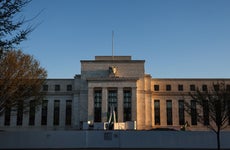How a new credit card can fight against inflation

The Bankrate promise
At Bankrate we strive to help you make smarter financial decisions. While we adhere to strict , this post may contain references to products from our partners. Here's an explanation for . The content on this page is accurate as of the posting date; however, some of the offers mentioned may have expired. Terms apply to the offers listed on this page. Any opinions, analyses, reviews or recommendations expressed in this article are those of the author’s alone, and have not been reviewed, approved or otherwise endorsed by any card issuer.
Key takeaways
- The ongoing impact of surging inflation in recent years has left many Americans tightening their wallets.
- One surprising solution for combating the negative impacts of inflation may be opening a new credit card that allows you to offset higher costs with cash back savings and other rewards.
- But while welcome bonuses, 0 percent intro APRs, rewards and miles can all help take the sting out of spending, it’s important to use these cards responsibly and limit the balance you carry.
For many Americans, inflation is a four-letter word. We’re cursing as we pay more at the gas pump, the grocery store and a lot of other places.
However, a new credit card — especially one offering hefty rewards and an attractive interest rate — could be a useful weapon in the fight against inflation. Just be sure you don’t diminish the power of that weapon by regularly carrying a balance on your credit card and paying interest. Also, remember to choose a card that fits your spending patterns.
The impact of inflation
After rising for more than a year, the Consumer Price Index (CPI) — one of the most widely used measures of inflation, which takes into account consumer prices for everything from groceries to gas — peaked at 9.1 percent in June 2022, according to the U.S. Bureau of Labor Statistics.
However, although this rate has since fallen to 3.3 percent as of May 2024, it’s still higher than the 2 percent inflation rate typically targeted by the Federal Reserve.
Translation: In the past few years, Americans’ purchasing power has eroded, meaning it takes more of our money to buy goods and services.
Unfortunately, even though there has been modest progress in Federal Reserve’s fight to lower inflation, Americans may not see immediate relief. That’s because the higher prices driven by inflation continue to diminish individuals’ ability to save. Without this cash cushion, consumers may be vulnerable to unexpected expenses and cover them by taking on high-interest debt.
Inflation impacting credit card debt
In an effort to curb inflation and cool off the economy, the Federal Reserve has maintained the target federal funds rate to a range of 5.25 percent to 5.50 percent — up from 0.75 percent to 1.00 percent at the start of June 2022.
When the Fed bumps up the federal funds rate, that action tends to trickle down to interest rates for credit cards. How? The closely monitored prime rate, used to set interest rates for credit cards, typically moves in tandem with the federal funds rate. In other words, if the prime rate climbs, the interest rates for credit cards are likely to climb as well.
As of June 2024, the average credit card interest rate stands at 20.68 percent, according to Bankrate. This increase — up from an average of 16.17 percent in 2022 — is making it more expensive for many consumers to carry a balance on their credit cards.
How a new credit card can help you fight inflation
Just as inflation nibbles away at the spending power of cash, it also can nibble away at the spending power of credit cards. However, credit cards with robust rewards, bonuses and benefits can help you fight inflation. This is especially true for new credit cards.
Credit card rewards such as cash back or points can save you money on your everyday spending. On top of that, the sign-up bonus you receive when opening a new rewards card can help cushion the blow of rising prices, especially if you’re planning a large purchase. Some credit cards also supply perks and benefits that can save you yet more out-of-pocket costs — for example, when you travel.
Of course, you can squeeze even more out of credit card rewards if you pay off your full balance every month. By doing so, you can avoid interest charges that drain value from credit card rewards.
What to consider when picking a credit card
If you’re considering credit cards that deliver inflation-fighting rewards, don’t randomly pick a card. Instead, examine your spending over the past few months so you can find a card that rewards your everyday expenses.
For instance, you may benefit from a credit card that provides an attractive amount of cash back on grocery purchases. Or maybe you’re traveling a lot now and would find an airline or hotel credit card more rewarding.
Generally speaking, rewards cards come in three categories — cash back, points and miles — and provide rewards on any eligible purchases.
Aside from checking out the rewards themselves, look for cards that extend a 0 percent intro APR for at least 12 or 15 months to further maximize their value (the best 0 percent APR cards offer up to 21 months). That said, if you do take advantage of one of these cards, don’t forget to pay off your balance before the 0 percent intro APR ends. Otherwise, the normal interest rate for the card will take effect.
Also, remember not to overlook the APR that the card issuer will charge outside the intro period. Choosing a card with a relatively low variable APR could save you some serious dough when it comes to long-term interest charges.
The bottom line
Inflation has triggered higher prices for everything from milk to Maseratis. As Americans continue to cope with inflation, some are finding that a new credit card — particularly one that offers lucrative rewards and a 0 percent introductory APR — can help blunt the effects of inflation.
Before you start shopping for the best rewards credit card to add to your inflation-fighting arsenal, consider whether cash back, points or miles will bring the most bang for your buck. Also, strive to keep your balances as low as possible so credit card interest charges don’t work against you.
Related Articles


Top high-yield savings accounts are now beating inflation. Here’s why that’s important

